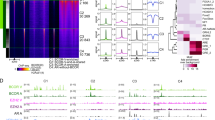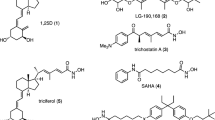Abstract
We hypothesized that key antiproliferative target genes for the vitamin D receptor (VDR) were repressed by an epigenetic mechanism in prostate cancer cells resulting in apparent hormonal insensitivity. To explore this possibility, we examined nuclear receptor corepressor expression in a panel of nonmalignant and malignant cell lines and primary cultures, and found frequently elevated SMRT corepressor mRNA expression often associated with reduced sensitivity to 1α,25-dihydroxyvitamin D3 (1α,25(OH)2D3). For example, PC-3 and DU-145 prostate cancer cell lines had 1.8-fold and twofold increases in SMRT mRNA relative to normal PrEC cells (P<0.05). Similarly, 10/15 primary tumour cultures (including three matched to normal cells from the same donors) had elevated SMRT mRNA levels; generally NCoR1 and Alien were not as commonly elevated. Corepressor proteins often have associated histone deacetylases (HDAC) and reflectively the antiproliferative action of 1α,25(OH)2D3 can be ‘restored’ by cotreatment with low doses of HDAC inhibitors such as trichostatin A (TSA, 15 nM) to induce apoptosis in prostate cancer cell lines. To decipher the transcriptional events that lead to these cellular responses, we undertook gene expression studies in PC-3 cells after cotreatment of 1α,25(OH)2D3 plus TSA after 6 h. Examination of known VDR target genes and cDNA microarray analyses revealed cotreatment of 1α,25(OH)2D3 plus TSA cooperatively upregulated eight (out of 1176) genes, including MAPK-APK2 and GADD45α. MRNA and protein time courses and inhibitor studies confirmed these patterns of regulation. Subsequently, we knocked down SMRT levels in PC-3 cells using a small interfering RNA (siRNA) approach and found that GADD45α induction by 1α,25(OH)2D3 alone became very significantly enhanced. The same distortion of gene responsiveness, with repressed induction of GADD45α was found in primary tumour cultures compared and to matched peripheral zone (normal) cultures from the same donor. These data demonstrate that elevated SMRT levels are common in prostate cancer cells, resulting in suppression of target genes associated with antiproliferative action and apparent 1α,25(OH)2D3-insensitivity. This can be targeted therapeutically by combination treatments with HDAC inhibitors.
This is a preview of subscription content, access via your institution
Access options
Subscribe to this journal
Receive 50 print issues and online access
$259.00 per year
only $5.18 per issue
Buy this article
- Purchase on Springer Link
- Instant access to full article PDF
Prices may be subject to local taxes which are calculated during checkout







Similar content being viewed by others
References
Akutsu N, Lin R, Bastien Y, Bestawros A, Enepekides DJ, Black MJ and White JH . (2001). Mol. Endocrinol., 15, 1127–1139.
Albertson DG, Ylstra B, Segraves R, Collins C, Dairkee SH, Kowbel D, Kuo WL, Gray JW and Pinkel D . (2000). Nat. Genet., 25, 144–146.
Alsayed Y, Uddin S, Mahmud N, Lekmine F, Kalvakolanu DV, Minucci S, Bokoch G and Platanias LC . (2001). J. Biol. Chem., 276, 4012–4019.
Beer TM, Eilers KM, Garzotto M, Egorin MJ, Lowe BA and Henner WD . (2003). J. Clin. Oncol., 21, 123–128.
Belandia B and Parker MG . (2003). Cell, 114, 277–280.
Blutt SE, Allegretto EA, Pike JW and Weigel NL . (1997). Endocrinology, 138, 1491–1497.
Blutt SE, Polek TC, Stewart LV, Kattan MW and Weigel NL . (2000). Cancer Res., 60, 779–782.
Campbell MJ, Elstner E, Holden S, Uskokovic M and Koeffler HP . (1997). J. Mol. Endocrinol., 19, 15–27.
Campbell MJ, Gombart AF, Kwok SH, Park S and Koeffler HP . (2000). Oncogene, 19, 5091–5097.
Campbell MJ, Park S, Uskokovic MR, Dawson MI and Koeffler HP . (1998). Endocrinology, 139, 1972–1980.
Chen TC and Holick MF . (2003). Trends Endocrinol. Metab., 14, 423–430.
Cohen LA, Marks PA, Rifkind RA, Amin S, Desai D, Pittman B and Richon VM . (2002). Anticancer Res., 22, 1497–1504.
Danielsson C, Mathiasen IS, James SY, Nayeri S, Bretting C, Hansen CM, Colston KW and Carlberg C . (1997). J. Cell. Biochem., 66, 552–562.
DeFouw LM and DeFouw DO . (2000). Tissue Cell, 32, 238–242.
Dwivedi PP, Hii CS, Ferrante A, Tan J, Der CJ, Omdahl JL, Morris HA and May BK . (2002). J. Biol. Chem., 277, 29643–29653.
Dwivedi PP, Omdahl JL, Kola I, Hume DA and May BK . (2000). J. Biol. Chem., 275, 47–55.
Feldman BJ and Feldman D . (2001). Nat. Rev. Cancer, 1, 34–45.
Germain P, Iyer J, Zechel C and Gronemeyer H . (2002). Nature, 415, 187–192.
Gnanapragasam VJ, Leung HY, Pulimood AS, Neal DE and Robson CN . (2001). Br. J. Cancer, 85, 1928–1936.
Grignani F, De Matteis S, Nervi C, Tomassoni L, Gelmetti V, Cioce M, Fanelli M, Ruthardt M, Ferrara FF, Zamir I, Seiser C, Grignani F, Lazar MA, Minucci S and Pelicci PG . (1998). Nature, 391, 815–818.
Guenther MG, Barak O and Lazar MA . (2001). Mol. Cell. Biol., 21, 6091–6101.
Hanchette CL and Schwartz GG . (1992). Cancer, 70, 2861–2869.
Hermanson O, Glass CK and Rosenfeld MG . (2002). Trends Endocrinol. Metab., 13, 55–60.
Hirose T, Sowa Y, Takahashi S, Saito S, Yasuda C, Shindo N, Furuichi K and Sakai T . (2003a). Oncogene, 22, 7762–7773.
Hirose T, Sowa Y, Takahashi S, Saito S, Yasuda C, Shindo N, Furuichi K and Sakai T . (2003b). Oncogene, 22, 7762–7773.
Hudelist G, Czerwenka K, Kubista E, Marton E, Pischinger K and Singer CF . (2003). Breast Cancer Res. Treat., 78, 193–204.
Ingles SA, Coetzee GA, Ross RK, Henderson BE, Kolonel LN, Crocitto L, Wang W and Haile RW . (1998). Cancer Res., 58, 1620–1623.
Jiang F, Li P, Fornace Jr AJ, Nicosia SV and Bai W . (2003a). J. Biol. Chem., 278, 48030–48040.
Jiang WG, Douglas-Jones A and Mansel RE . (2003b). Int. J. Cancer, 106, 752–757.
Jin S, Fan F, Fan W, Zhao H, Tong T, Blanck P, Alomo I, Rajasekaran B and Zhan Q . (2001). Oncogene, 20, 2683–2690.
Jin S, Mazzacurati L, Zhu X, Tong T, Song Y, Shujuan S, Petrik KL, Rajasekaran B, Wu M and Zhan Q . (2003). Oncogene, 22, 8536–8540.
Kawashima H, Takano H, Sugita S, Takahara Y, Sugimura K and Nakatani T . (2003). Biochem. J., 369, 163–171.
Kollara A, Kahn HJ, Marks A and Brown TJ . (2001). Breast Cancer Res. Treat., 67, 245–253.
Konety BR, Schwartz GG, Acierno Jr JS, Becich MJ and Getzenberg RH . (1996). Cell Growth Differ., 7, 1563–1570.
Krishnan AV, Peehl DM and Feldman D . (2003). Recent Results Cancer Res., 164, 205–221.
Kubota T, Koshizuka K, Koike M, Uskokovic M, Miyoshi I and Koeffler HP . (1998). Cancer Res., 58, 3370–3375.
Lin RJ, Nagy L, Inoue S, Shao W, Miller Jr WH and Evans RM . (1998). Nature, 391, 811–814.
Liu M, Lee MH, Cohen M, Bommakanti M and Freedman LP . (1996). Genes Dev., 10, 142–153.
Ly LH, Zhao XY, Holloway L and Feldman D . (1999). Endocrinology, 140, 2071–2076.
Metivier R, Penot G, Hubner MR, Reid G, Brand H, Kos M and Gannon F . (2003). Cell, 115, 751–763.
Miller CW, Morosetti R, Campbell MJ, Mendoza S and Koeffler HP . (1997). Mol. Carcinogen., 19, 254–257.
Miller GJ, Stapleton GE, Hedlund TE and Moffat KA . (1995). Clin. Cancer Res., 1, 997–1003.
Mori T, Anazawa Y, Matsui K, Fukuda S, Nakamura Y and Arakawa H . (2002). Neoplasia, 4, 268–274.
Munker R, Norman A and Koeffler HP . (1986). J. Clin. Invest., 78, 424–430.
Oda Y, Sihlbom C, Chalkley RJ, Huang L, Rachez C, Chang CP, Burlingame AL, Freedman LP and Bikle DD . (2003). Mol. Endocrinol., 17, 2329–2339.
Palmer HG, Gonzalez-Sancho JM, Espada J, Berciano MT, Puig I, Baulida J, Quintanilla M, Cano A, de Herreros AG, Lafarga M and Munoz A . (2001). J. Cell Biol., 154, 369–387.
Peehl DM . (2004). J. Cell. Biochem., 91, 185–195.
Peehl DM and Feldman D . (2003). Endocr. Relat. Cancer, 10, 131–140.
Peehl DM, Skowronski RJ, Leung GK, Wong ST, Stamey TA and Feldman D . (1994). Cancer Res., 54, 805–810.
Planas-Silva MD, Shang Y, Donaher JL, Brown M and Weinberg RA . (2001). Cancer Res., 61, 3858–3862.
Polek TC, Stewart LV, Ryu EJ, Cohen MB, Allegretto EA and Weigel NL . (2003). Endocrinology, 144, 50–60.
Polly P, Herdick M, Moehren U, Baniahmad A, Heinzel T and Carlberg C . (2000). FASEB J., 14, 1455–1463.
Quack M and Carlberg C . (1999). Mol. Pharmacol., 55, 1077–1087.
Rachez C and Freedman LP . (2000). Gene, 246, 9–21.
Rachez C, Gamble M, Chang CP, Atkins GB, Lazar MA and Freedman LP . (2000). Mol. Cell. Biol., 20, 2718–2726.
Rashid SF, Moore JS, Walker E, Driver PM, Engel J, Edwards CE, Brown G, Uskokovic MR and Campbell MJ . (2001a). Oncogene, 20, 1860–1872.
Rashid SF, Mountford JC, Gombart AF and Campbell MJ . (2001b). Steroids, 66, 433–440.
Ratnam AV, Bikle DD, Su MJ and Pillai S . (1996). J. Invest. Dermatol., 106, 522–525.
Reid G, Hubner MR, Metivier R, Brand H, Denger S, Manu D, Beaudouin J, Ellenberg J and Gannon F . (2003b). Mol. Cell, 11, 695–707.
Reid G, Hubner MR, Metivier R, Brand H, Denger S, Manu D, Beaudouin J, Ellenberg J and Gannon F . (2003a). Mol. Cell, 11, 695–707.
Schmid HP and McNeal JE . (1992). Am. J. Surg. Pathol., 16, 184–191.
Schwartz GG, Wang MH, Zang M, Singh RK and Siegal GP . (1997). Cancer Epidemiol. Biomarkers Prev., 6, 727–732.
Sommerville J, Baird J and Turner BM . (1993). J. Cell Biol., 120, 277–290.
Tong WM, Bises G, Sheinin Y, Ellinger A, Genser D, Potzi R, Wrba F, Wenzl E, Roka R, Neuhold N, Peterlik M and Cross HS . (1998). Int. J. Cancer, 75, 467–472.
Wang DF, Wiest O, Helquist P, Lan-Hargest HY and Wiech NL . (2004). Bioorg. Med. Chem. Lett., 14, 707–711.
Wang X, Rao J and Studzinski GP . (2000). Exp. Cell Res., 258, 425–437.
Yamashita Y, Shimada M, Harimoto N, Rikimaru T, Shirabe K, Tanaka S and Sugimachi K . (2003). Int. J. Cancer, 103, 572–576.
Yoshida M, Horinouchi S and Beppu T . (1995). Bioessays, 17, 423–430.
Yu J, Li Y, Ishizuka T, Guenther MG and Lazar MA . (2003). EMBO J., 22, 3403–3410.
Zhang C, Baudino TA, Dowd DR, Tokumaru H, Wang W and MacDonald PN . (2001). J. Biol. Chem., 276, 40614–40620.
Zhu WG and Otterson GA . (2003). Curr. Med. Chem. Anti-cancer Agents, 3, 187–199.
Zhuang SH, Schwartz GG, Cameron D and Burnstein KL . (1997). Mol. Cell Endocrinol., 126, 83–90.
Zierold C, Mings JA, Prahl JM, Reinholz GG and DeLuca HF . (2002). Arch. Biochem. Biophys., 404, 18–24.
Zinser G, Packman K and Welsh J . (2002). Development, 129, 3067–3076.
Acknowledgements
This work was supported in part by the Cancer Research Fund, under Interagency Agreement #97-12013 (University of California, Davis Contract #98-00924 V) with the Department of Health Services, Cancer Research Section. Mention of trade name, proprietary product or specific equipment does not constitute a guaranty or warranty by the Department of Health Services, nor does it imply approval to the exclusion of other products. The views expressed herein represent those of the authors and do not necessarily represent the position of the State of California, Department of Health Services (DMP). This work was supported in part by grants from the United Birmingham Hospitals Endowment Fund, Prostate Research Campaign UK, and National Cancer Research Institute Prostate Research Cancer Collaborative, UK (MJC).
Author information
Authors and Affiliations
Corresponding author
Rights and permissions
About this article
Cite this article
Khanim, F., Gommersall, L., Wood, V. et al. Altered SMRT levels disrupt vitamin D3 receptor signalling in prostate cancer cells. Oncogene 23, 6712–6725 (2004). https://doi.org/10.1038/sj.onc.1207772
Received:
Revised:
Accepted:
Published:
Issue Date:
DOI: https://doi.org/10.1038/sj.onc.1207772
Keywords
This article is cited by
-
Vitamin D and schizophrenia: 20 years on
Molecular Psychiatry (2021)
-
Identification of transcription factor co-regulators that drive prostate cancer progression
Scientific Reports (2020)
-
LSD1 dual function in mediating epigenetic corruption of the vitamin D signaling in prostate cancer
Clinical Epigenetics (2017)
-
Elevated nuclear expression of the SMRT corepressor in breast cancer is associated with earlier tumor recurrence
Breast Cancer Research and Treatment (2012)
-
Impact of vitamin D metabolism on clinical epigenetics
Clinical Epigenetics (2011)



